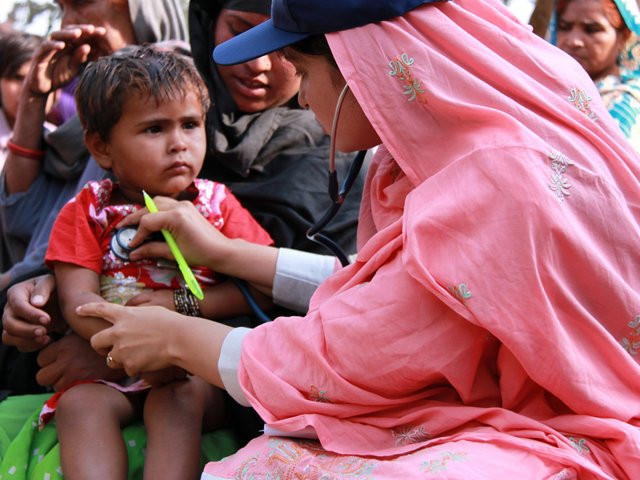
This was claimed in Pakistan Demographic and Health Survey (PDHS) for 2017-18 which was unveiled on Monday. This is the fourth DHS survey to be conducted in Pakistan since 1990-91.
The survey results, which were released in a national seminar in Islamabad, were organized by the National Institute of Population Studies (NIPS).
The survey highlights major improvements in child survival and maternal health care. While slower, progress has been made in nutrition and family planning use, especially amongst women.
Parliamentary Secretary for the Health Ministry Nosheen Hamid stated that the survey provides key data on reproductive health, nutrients, family planning, disability, migration and violence against woman.
This data, she said, can be used by programme managers to develop effective strategies and planning for maternal and child health initiatives.
Maternal, child health care: Twoneonatal emergency centres to open soon
The survey highlights how much more work has to be done by UN child and maternal health programmes in the country to make it more result-oriented.
“It will help us achieve PM Imran Khan’s vision of a healthy Pakistan by providing better health services to children and mothers.”
According to the survey, more children in Pakistan are surviving early in their childhood than ever before with the under-5 mortality rate declining sharply.
Currently, the under-5 mortality rate is 74 deaths per 1,000 live births, down from 89 deaths per 1,000 live births in 2012-13. This means that approximately one in every 14 children in Pakistan does not make it to their fifth birthday.
One of the biggest reasons for this is improvement in basic vaccination coverage with two in three children between the ages of 12-23 months receiving all eight basic vaccinations. This is up from more than half of children in 2012-13.
However, the survey found that basic vaccination coverage was lowest in Balochistan (29%) and highest in Punjab (80%), signifying the gulf in health services but also in the challenges involved.
Reproductive health care coverage in Pakistanis has also improved with nearly 9 out of every 10 women between the ages of 15-49 receiving antenatal care from skilled healthcare providers such as doctors, nurses, midwives, or lady health visitors.
Additionally, more than half of women have their first antenatal care visit in the first trimester, as recommended by the World Health Organisation (WHO).
Half of women make four or more antenatal care visits over the course of their pregnancy, a notable increase from 37% in the 2012-13 survey.
Furthermore, more babies are being delivered in formal health facilities, up from just 48% in 2012-13 to 66% in 2017-18.
However, one in three births are still delivered outside a healthcare centre.
Further, there has been massive internal migration in the country with one in nine people having moved to their current residence from another place, while 14% of households have at least one out-migrating member.
Child and maternal health: Healthy mothers lead to healthy society
The most common reasons for out-migration are better economic opportunity and marriage, the survey found.
For the first time, the 2017-18 PDHS provides information on disability. Among adults aged 15 and older, 9% of women and 7% of men have a lot of difficulty or cannot function in at least one domain of disability – seeing, hearing, communicating, remembering or concentrating, walking or climbing steps, and washing all over or dressing.
Dr Ruth Lawson, Head of Basic Services at the UK’s Department for International Development (DFID) stated, “The UK is proud to have partnered for the survey, as good data leads to evidence-based decision making both by the Government and development partners.
I’m glad that this survey reports on disability as well, as DFID’s programmes are especially focused on leaving no-one-behind.” While the 2017-18 PDHS reports progress in many areas, challenges remain particularly in nutrition, family planning, and domestic violence.
The survey shows that many children in Pakistan suffer from poor nutrition. One sign of chronic under-nutrition is stunting, or being too short for one’s age. Although stunting has declined since 2012-13 when 45% of children under 5 were stunted, still 38% of children in Pakistan are too short for their age
. Currently, women in Pakistan are more overweight or obese than ever before, 52% of women age 15-49 in 2017-18 as compared to 40% in 2012-13.
Pakistan has one of the highest fertility rates in the region with an average of 3.6 births per woman. The use of family planning among married women has stagnated around 34% over the last five years.
The unmet need for contraception remains high at 17%.More work needs to be done to improve the availability and choice of family planning information and services. USAID Deputy Mission Director, Helen Pataki, noted that the PDHS is not just a report card on the last five years; it also directs our efforts for the next five.
“Together, we can review what has worked well and where further support could make a difference to improve basic health care and end preventable deaths.”
More than 1 in 4 ever-married women (28%) have experienced physical violence since age 15, and 6% have experienced sexual violence. Seven percent of women who have ever been pregnant have experienced violence during pregnancy.
Three in ten women who have ever experienced physical or sexual violence sought help to stop the violence, yet 56% never sought help nor told anyone.
Ms. Lina Mousa, UNFPA Representative said, “UNFPA is very proud to have contributed, both financially and technically, to the successful implementation of the 2017-18 PDHS, and congratulate the National Institute of Population Studies (NIPS) and Government of Pakistan for this timely achievement.
” She commended the strategic partnership of UNFPA with NIPS and Pakistan Bureau of Statistics on strengthening the national data system that is essential for development planning in the context of the SDGs and the International Conference for Population and Development.
“Population censuses and PDHS surveys are crucial to the development of national strategies and socio-economic plans as well as localization of the SDGs.”
The 2017-18 PDHS provides estimates at the national level; for urban and rural areas separately; for four provinces including Punjab, Sindh, Khyber Pakhtunkhwa, and Balochistan; for two regions including Azad Jammu and Kashmir (AJK) and GilgitBaltistan (GB); Islamabad Capital Territory; and FATA. The national total for indicators does not includeAJK and GB.
The 2017-18 PDHS was implemented by NIPS under the aegis of the Ministry of National Health Services, Regulations,and Coordination, Islamabad, Pakistan. ICF provided technical assistance through.
The DHS Program, a project funded by USAID that provides financial support and technical assistance in the implementation of population and health surveys in countries worldwide. Support for the survey was also provided by DFID and UNFPA. DNA
Published in The Express Tribune, February 26th, 2019.


1725254039-0/Untitled-design-(24)1725254039-0-270x192.webp)















COMMENTS
Comments are moderated and generally will be posted if they are on-topic and not abusive.
For more information, please see our Comments FAQ